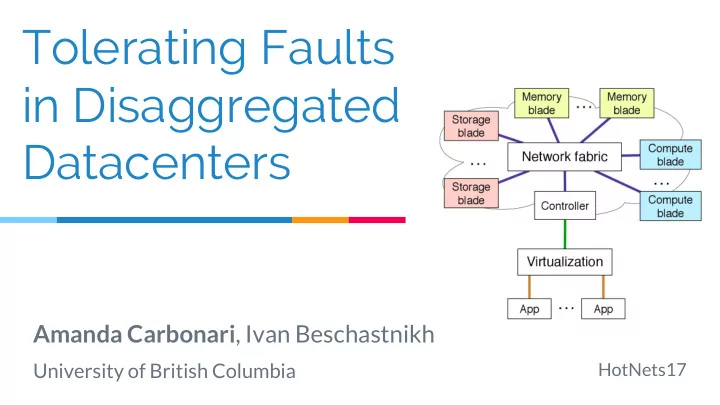

Tolerating Faults in Disaggregated Datacenters Amanda Carbonari , Ivan Beschastnikh University of British Columbia HotNets17
Today’s Datacenters 2
The future: Disaggregation 3
The future: Disaggregation The future: Disaggregation is coming ▷ Intel Rack Scale Design, Ericsson Hyperscale Datacenter System 8000 ▷ HP The Machine ▷ UC Berkeley Firebox 4
Disaggregation Research Space Network + disaggregation [R2C2 ToR SIGCOMM’15, Gao et. al. OSDI’16] CPU blade Memory disaggregation [Rao et. al. Memory blade ANCS’16, Gu et. al. NSDI’17, Aguilera et. al. Storage blade SoCC’17] Flash/Storage disaggregation [Klimovic et. al. EuroSys’16, Legtchenko et. al. HotStorage’17, Decibel NSDI’17] Our research focus: how to build systems on DDCs 5
Our Assumptions Rack-scale Partial Disaggregation ToR ToR ToR CPU blade CPU blade CPU blade Memory Memory CPU Memory CPU CPU blade blade blade Memory Mem Mem Storage Storage Storage CPU CPU CPU blade blade blade Memory Mem Mem Memory Blade CPU Blade 6
What happens if a resource fails? How should applications observe resource failures? DC: resources fate share DDC: resources do not fate share Server Disaggregated Server DDC fate sharing should be enforced in the network . 7
Why enforce fate sharing in the network? ▷ Reasonable to assume legacy applications will run on DDCs unmodified ▷ All memory accesses are across the rack network ▷ Interposition layer = Software Defined Networking (SDN) 8
Fault tolerance in DDCs ▷ Fate sharing exposes a failure type to higher layers ( failure granularity ) ▷ Techniques inspired by related work Distributed systems [Bonvin et. al. SoCC’10, GFS ○ OSDI’03, Shen et. al. VLDB’14, Xu et. al. ICDE’16] HA VMs and systems [Bressoud et. al. SOSP’95, Bernick ○ et. al. DSN’05, Remus NSDI’08] HPC [Bronevetsky et. al. PPoPP’03, Egwutuoha et. al. Journal ○ of Supercomputing’13] ▷ Open research question: how to integrate existing fault tolerance techniques into DDC? 9
Fate Sharing Granularities 10
Tainted Fate Sharing ▷ Memory fails → CPU reading/using memory fails with ▷ CPU fails while writing to one replica → inconsistent memory fails ( v 1 ) ▷ Modularity vs. performance ▷ Open research question: implications of dynamic computation in-network 11
Fate Sharing Granularities DDC fate sharing should be both enforced by the network Serverless? Containers? and programmable . 12
Programmable Fate Sharing ▷ Goal: can describe an arbitrary fate sharing model and install in the network ▷ Model specification includes Failure detection ○ Failure domain ○ Failure mitigation (optional) ○ ▷ Open research questions: Who should define the specification? ○ What workflow should be used for transformation of specification to ○ switch machine code? 13
Proposed Workflow 14
Fate Sharing Specification ▷ Provides interface between components ▷ High-level language → high-level networking language [1] → compiles to switch ▷ Open research questions: ○ Spec verification? ○ Language and switch requirements for expressiveness? [1] FatTire HotSDN’13, NetKAT POPL’14, Merlin CoNEXT’14, P4 CCR’14, SNAP SIGCOMM’16 15
Vision: programmable , in-network fate sharing Open research questions ▷ Failure semantics for GPUs? Storage? ▷ Switch or controller failure? ▷ Correlated failures? ▷ Other non-traditional fate sharing models? Thank you! 16
Backup slides 17
18
In-Network Memory Replication ▷ Port mirror CPU operations to memory replicas, automatically recovers replica during failure ▷ Challenges: coherency, network delay, etc. ▷ Different assumptions than previous work Persistent storage backings [Sinfonia SOSP’07, RAMCloud SOSP’11, ○ FaRM NSDI’14, Infiniswap NSDI’17] ▷ Must consider network requirements Combined solutions [GFS OSDI’03, Ceph OSDI’06] ○ Performance sensitive [Costa et. al. OSDI’96] ○ 19
In-Network CPU Checkpointing ▷ Controller checkpoints processor state to remote memory (state attached operation packets) ▷ Challenges: consistent client view, checkpoint retention, non-idempotent operations, etc. ▷ Different requirements than previous work Low tail-latency [Remus NSDI’08, Bressoud et. al. SOSP’95] ○ ▷ Similar trade-offs (application specific vs generality) Protocol [DMTCP IPDPS’09, Bronevetskey et. al. PPoPP’03] ○ Workflow [Shen et. al. VLDB’14, Xu et. al. ICDE’16] ○ 20
Passive Application Monitoring ▷ Defines what information must be collected during normal execution Domain table ○ Context information ○ Application protocol headers ○ cpu_ip memory_ip start ack x.x.x.x x.x.x.x t s t a src IP src port dst IP dst port rtype op tstamp 21
Application Failure Notification ▷ Spec defines notification semantics ▷ When controller gets notified of failure → notifies application 22
Active Failure Mitigation ▷ Defines how to generate a failure domain and what rules to install on the switch ▷ Compares every domain entry to failed resource to build failure domain ▷ Installs rules based on mitigation action 23
In-Network Memory Recovery Normal Execution 24
In-Network Memory Recovery Under Failure 25
Recommend
More recommend